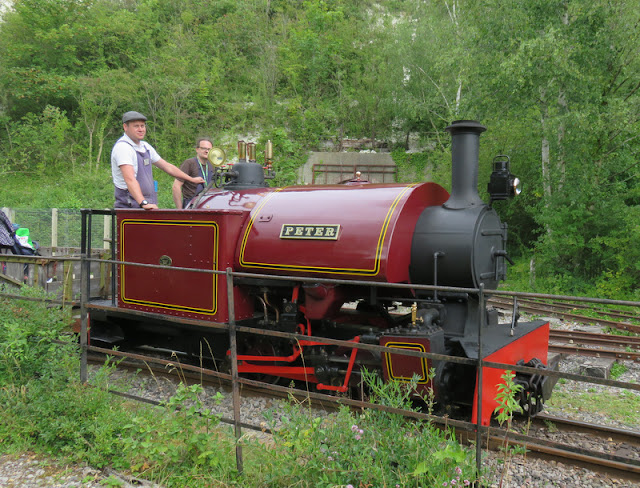At the SWING show a few weeks ago one of the traders was selling some second hand 009, including some interesting "projects". I restrained myself to three...
In the centre is a Wickham Trolley etched kit. I doubt it is practical to motorise in 009, I'm thinking it will be an interesting scenic item for Hexworthy.
On the right is what appears to be a 3D print with (I think) a Meridian chassis. Other than a broken wire, one of the layshaft worms isn't meshing with the axle, yet there's no obvious scope for adjustment. For £5, this is worth a play,
Most interesting is the loco on the left. It's a Kerr Stuart Haig class I believe, I had assumed a scratch-build at first glance, on closer inspection I recognise the work of Paul Windle. The chassis is an adapted Bachmann, it looks like Paul removed the motor from the rear overhang and mounted it backwards over the wheels using a brass mounting, but the motor is missing. In the box with it were two coreless motors and a Mashima, the latter with a worm already fitted. Also just £5, this is a bargain even as a static model.
The unmotored chassis rolled, but there was a slight bind once per wheel revolution, and it was full of crud. In the end I decided to strip it, this involves removing the stub-axle wheeels, undoing a screw each side, and removing the metal sides to give access to the geartrain in the plastic. The whole lot were wiped clean of accumulated oily dirt. All the gears look good with no sign of splitting.
The metal sides work as split-frame current pick-up, but wire wipers had been soldered on (see bottom frame) so perhaps relying on the stub axles wasn't reliable. However, there's not much space behind the wheels and I wondered if the wire was putting too much uneven pressure on the wheels. I replaced them with a strip of phosphor bronze (as seen on the upper frame), although the size of the sideframe was a challenge for my 25W iron.
Re-assembly required the wheels to be pushed in place in line with each other, and quartered to the other side. Fortunately since the axles are gear driven, and there's a fair ammount of slop in the gears and the coupling rod, this isn't critical. Even better, now the chassis rolls without any binding, it's not super-free running but it is smooth.
The next challenge is fitting a motor. I'll use the Mashima as it looks a good fit.
Option 1: I guess I could stick it to the brass plate with a lump of araldite or sealant, crude but it might work. It's only held by the screw at the front though, and located by the wire under the plastic lip at the rear of the chassis - but that's how the original motor was fitted.
Option 2: I could make up a new motor cradle, from brass or plastic, also held by the screw at the front. It would still probably rely on glue to hold the motor but perhaps could be a closer fitting shape.
Option 3: I could use the screw holes on the front of the motor to screw it to a vertical brass plate, which could itself be stuck to the chassis block via an L-shape at the bottom, perhaps also with a fold under the lip. This allows for motor removal and doesn't rely on the bolt at the front, but may need more precision than I can manage, I don't have motor screws, and the worm is on the wrong end of the motor!
I should note that the slide bars and motion assembly is held to the top of the chassis by the brass motor mount, so whatever I do needs to hold that in place too.





































